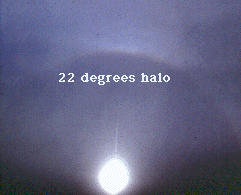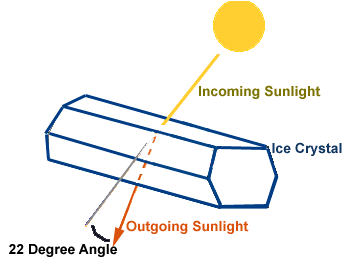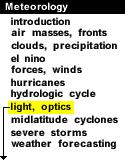
|
A halo is a ring of light surrounding the sun or moon. Most halos appear as bright white rings but in some instances, the dispersion of light as it passes through ice crystals found in upper level cirrus clouds can cause a halo to have color.

Photograph by: Rauber |
Halos form when light from the sun or moon is refracted by ice crystals associated with thin, high-level clouds (like cirrostratus clouds). A 22 degree halo is a ring of light 22 degrees from the sun (or moon) and is the most common type of halo observed and is formed by hexagonal ice crystals with diameters less than 20.5 micrometers. |
Light undergoes two refractions as it passes through an ice crystal and the amount of bending that occurs depends upon the ice crystal's diameter.

A 22 degree halo develops when light enters one side of a columnar ice crystal and exits through another side. The light is refracted when it enters the ice crystal and once again when it leaves the ice crystal.

The two refractions bend the light by 22 degrees from its original direction, producing a ring of light observed at 22 degrees from the sun or moon.

Photograph by: Knupp |
A tangent arc is a patch of bright light that is occasionally observed along a halo. This occurs when sunlight is refracted by falling hexagonal "pencil-shaped" ice crystals whose long axes are oriented horizontally. |

air, dust, haze |
|

46 degree halo |





